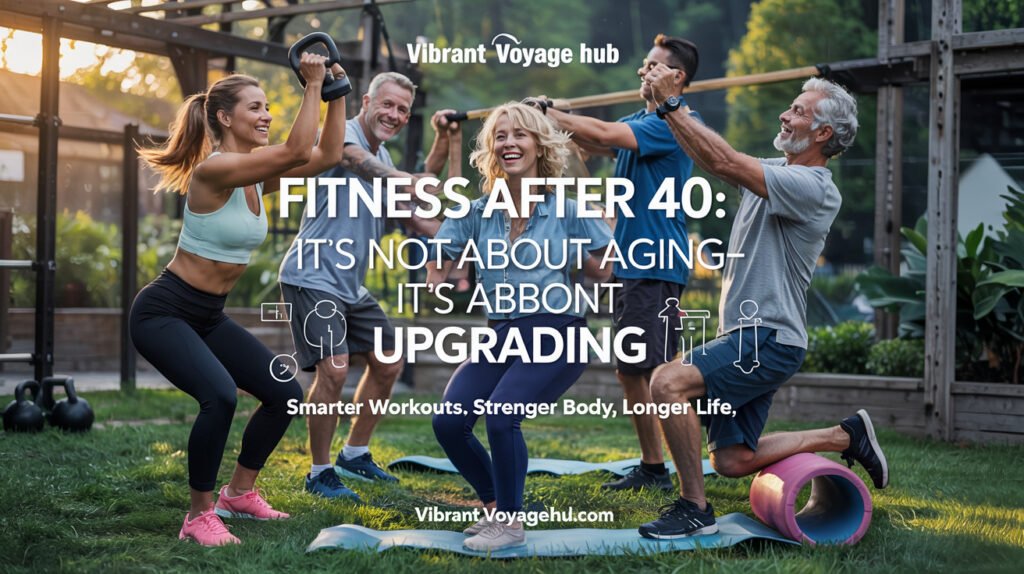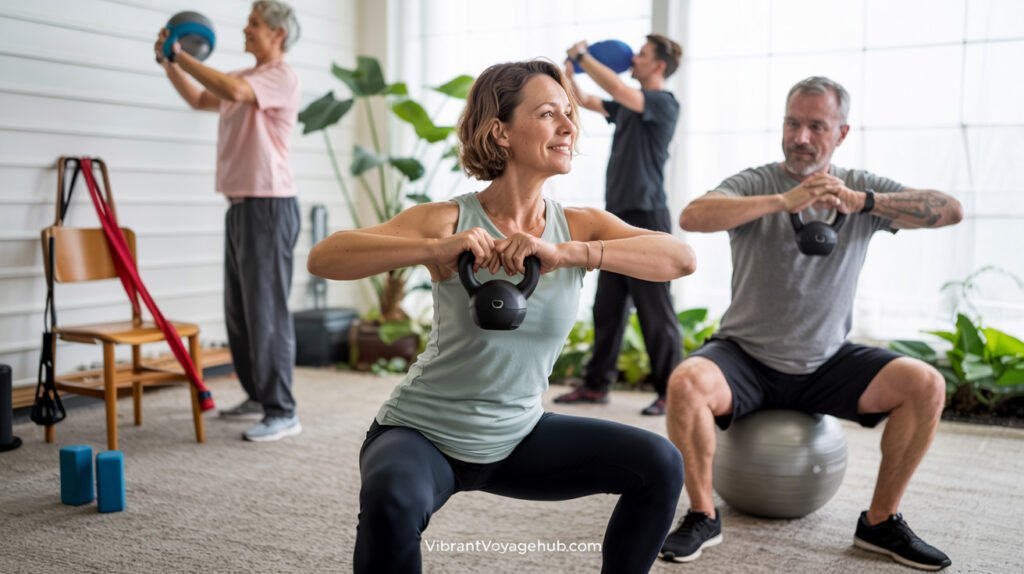Fitness After 40: The Best Workouts for Staying Lean & Energized
Are you over 40 and wondering if it’s too late to start or continue your fitness journey? As we age, our bodies undergo significant changes that can impact our strength and overall health.
As we age beyond 40, we lose muscle mass and bone density, making regular exercises crucial for a healthy lifestyle. Diversifying your workout routine can ensure a holistic approach to fitness, helping you stay lean and energized.
Adapting your workout routine to your changing physiology is key. This involves focusing on exercises that improve strength, mobility, and overall body health.
Key Takeaways
- Understand how to maintain and improve fitness after 40.
- Learn how to adapt your workout routine to your changing body.
- Discover exercises that help you stay lean and energized.
- Find out how to structure your fitness routine for maximum results.
- Minimize injury risk while maximizing strength and mobility.
The Changing Physiology After 40
As you hit 40, your body undergoes significant changes that impact your overall health and fitness. The natural aging process brings about a decline in various physiological processes.
Natural Muscle Loss and Metabolic Changes
After 40, you experience a natural decline in muscle mass, known as sarcopenia, which can reduce strength and metabolism. According to the National Health and Nutrition Examination Survey, health risks increase significantly after age 40. As you get older, your body‘s composition changes, making it easier to gain fat and harder to maintain muscle without proper intervention.
| Physiological Change | Impact on the Body |
|---|---|
| Sarcopenia (Muscle Loss) | Reduced strength and metabolic rate |
| Metabolic Slowdown | Increased fat gain, decreased muscle maintenance |
| Hormonal Shifts | Changes in body composition |
Why Traditional Workouts May No Longer Work
The workouts that were effective in your 20s and 30s may not be as effective after 40 due to the natural decline in physiological processes. As your body changes with age, it’s essential to adjust your exercise and nutrition strategies to maintain health and fitness.
Why Fitness Becomes Even More Critical After 40
After 40, the importance of fitness escalates, becoming a cornerstone of long-term health. Regular exercise is no longer just about aesthetics; it’s crucial for preventing age-related diseases and maintaining independence as you age.
Long-term Health Benefits
Consistent fitness routines significantly reduce your risk of developing heart disease, type 2 diabetes, and certain cancers—conditions that become more prevalent after 40. Strength training, in particular, helps prevent osteoporosis by maintaining bone density, which naturally decreases with age, especially in women after menopause.

Quality of Life Improvements
Regular exercise improves cognitive function and may help prevent neurodegenerative diseases like Alzheimer’s. It also helps manage chronic pain conditions, including back pain and arthritis, and reduces the risk of injury. Moreover, maintaining fitness enhances energy levels, sleep quality, mood, and resilience to stress.
Strength Training: The Foundation of Fitness After 40

Strength training is a vital component of any fitness regimen, especially after the age of 40, when natural muscle loss accelerates. As you get older, your body undergoes various physiological changes that can impact your overall health and fitness. One of the most significant changes is the loss of muscle mass, which can lead to reduced strength, mobility, and metabolism.
Recommended Frequency and Intensity
For optimal results, aim for 2-3 strength training sessions per week, focusing on compound movements that work multiple muscle groups simultaneously. This approach not only enhances efficiency but also helps in building overall muscle strength. When it comes to intensity, it’s crucial to strike a balance between challenging yourself and avoiding injury. Using moderate weights with proper form is generally more effective than lifting maximum weights that can compromise your technique.
Essential Strength Movements for Aging Bodies
Certain exercises are particularly beneficial for aging bodies, as they help maintain strength, improve posture, and enhance mobility. These movements can be modified to accommodate any physical limitations or previous injuries, making them accessible to everyone.
Goblet Squats
Goblet squats are an excellent exercise for strengthening the lower body while being gentle on the knees and back. To perform a goblet squat, hold a dumbbell or kettlebell close to your chest, stand with your feet shoulder-width apart, lower into a squat keeping your chest lifted, and then push through your heels to return to standing.
Push-Ups and Modifications
Push-ups are a versatile exercise that can be modified to suit different strength levels. From wall push-ups to standard floor versions, this exercise helps improve upper body strength and can be adapted to accommodate any physical limitations.
Bent-Over Rows
Bent-over rows are crucial for maintaining back strength and improving posture, which becomes increasingly important as desk jobs and technology use contribute to poor alignment. This exercise targets the back muscles and can be performed with dumbbells or a barbell.
Cardiovascular Exercise for Heart Health and Fat Loss

As you age, cardiovascular exercise becomes crucial for maintaining heart health and losing fat. Regular cardio workouts not only improve cardiovascular health but also enhance your ability to lose fat and maintain weight loss.
Finding Your Optimal Heart Rate Zone
To maximize the benefits of cardio exercise, it’s essential to understand your optimal heart rate zone. For heart health benefits, you need to exercise at 80% of your maximum heart rate for at least 30 minutes, 3 to 4 times a week. This intensity should feel effortful, like you’re working at around an 8 on a scale of 1 to 10.
Low-Impact vs. High-Impact Options
When choosing a cardio workout, consider low-impact options like swimming, cycling, or using an elliptical machine, which are easier on the joints. High-impact activities like running or jumping can be effective but may be more suitable for those with good joint health. The key is to select a workout that you enjoy and can stick to consistently.
Mobility and Flexibility: Preventing Injury and Pain
Mobility and flexibility are key components of a well-rounded fitness routine, especially after 40. As you age, your joints and muscles undergo natural changes that can affect your range of motion and overall fitness. Understanding the importance of mobility and flexibility can help you prevent injuries and alleviate pain.
Mobility refers to the active range of motion in your joints, while flexibility is the passive range of motion. Both are crucial for maintaining optimal movement and preventing discomfort. For instance, dead hangs are an excellent exercise for improving shoulder mobility, decompressing the spine, and strengthening your grip. To perform a dead hang, grab a pull-up bar with an overhand grip, hang with your arms fully extended, keeping your shoulders engaged, and hold for 30 seconds.

Joint-Friendly Mobility Exercises
Incorporating joint-friendly mobility exercises into your routine can significantly improve your overall mobility. Focus on exercises that target common problem areas such as the shoulders, hips, and spine. Some effective exercises include shoulder rolls, hip circles, and spinal twists. These movements help maintain joint health and prevent stiffness, ensuring that you can continue to perform daily activities with ease.
For example, you can start with simple exercises like shoulder rolls: Roll your shoulders forward and backward in a circular motion. Repeat this movement 10-15 times to loosen up your shoulder muscles.
Incorporating Stretching Into Your Routine
Stretching is another critical component of maintaining flexibility. It’s recommended to incorporate dynamic stretching before your workouts to prepare your muscles for the upcoming exercise. After your workout, static stretching can help improve flexibility and reduce muscle soreness.
| Stretching Type | When to Use | Benefits |
|---|---|---|
| Dynamic Stretching | Before Workout | Prepares muscles for exercise, improves performance |
| Static Stretching | After Workout | Improves flexibility, reduces muscle soreness |
By incorporating these mobility and flexibility exercises into your daily routine, you can alleviate existing pain conditions and prevent new ones from developing. Moreover, creating a time-efficient mobility routine can be achieved by performing simple exercises at your desk or during daily activities, making it easier to stay consistent with your fitness goals.
Core Strengthening to Combat Back Pain
Strengthening your core is crucial for preventing back pain, a condition that affects a significant portion of the adult population. Up to 80% of adults experience back pain at some point, with the risk increasing substantially after the age of 40 due to degenerative changes and cumulative strain.

Traditional core exercises like crunches can sometimes exacerbate back issues, whereas properly performed planks and functional movements can better support spinal health. The plank is particularly effective as it tones all of the core muscles. To perform a plank correctly, stack your wrists under your elbows, position your elbows under your shoulders, and push the floor away from you with your feet. Your legs should be outstretched behind you, with your feet shoulder-distance apart. It’s also essential to pull your bellybutton towards your spine to engage your abs. Hold this position for 30 seconds, take a short break on your knees, and then repeat the exercise two more times.
The Plank and Its Variations
The plank is a foundational core exercise that can be modified to suit different fitness levels and back conditions. By adjusting the duration and incorporating variations, you can progressively challenge your core stability. For instance, you can start with holding a plank for 30 seconds and gradually increase the time as your core strength improves.
Functional Core Exercises
In addition to planks, incorporating functional core exercises into your routine can help train your midsection for real-life movements, making them more effective for preventing back pain. These exercises engage your deep core muscles, including the transverse abdominis, which provides critical spinal support. By building both strength and endurance in your core, you can develop a robust defense against back pain.
To further enhance your core strength, consider incorporating a variety of exercises that challenge your core stability and promote overall spinal health. This comprehensive approach will not only help in preventing back pain but also contribute to a stronger, more resilient core.
The Complete Weekly Workout Plan for 40+ Fitness
Now that we’ve covered the essential components of fitness after 40, it’s time to put them together into a comprehensive workout plan. This plan is designed to help you maintain strength, mobility, and overall health, with a focus on exercises that are safe and effective for adults over 40.

3-Day Workout Schedule
A balanced 3-day workout schedule is ideal for most adults over 40. This routine should include a mix of strength training, cardiovascular exercise, and mobility work. For example, you can perform the following workout routine three to four times per week:
- Goblet Squats – 10 reps
- Push-Ups – 12 reps
- Step-Through Lunges – 8 reps per leg
- Bent-Over Rows – 10 reps
- Dead Hangs – 30 seconds
- Farmer’s Carry – 30 seconds
- Plank with Shoulder Taps – 10 reps per side
Complete 3 rounds, resting 30-60 seconds between rounds. If you’re short on time, do a single round as a quick maintenance session.
4-Day Advanced Option
For those with more experience or time availability, a 4-day workout schedule can provide additional benefits. This can be achieved by adding an extra day of strength training or cardiovascular exercise. For example, you can add an extra day of strength training focusing on different muscle groups, or an extra day of cardiovascular exercise such as cycling or swimming.
To progress these workouts over time, you can increase the number of reps, sets, or weight used, or decrease rest time between rounds. It’s essential to listen to your body and only make adjustments that feel safe and manageable.
Nutrition Strategies to Support Your Fitness After 40
As metabolism slows down with age, adjusting your nutrition becomes key to maintaining muscle mass and energy levels after40. Your dietary needs change, making it crucial to focus on the right foods to support your fitness goals.
Protein Requirements for Muscle Maintenance
After40, your body requires more protein to build muscle and repair tissues. Aim for a daily intake of1.2-1.6 grams of protein per kilogram of body weight to support muscle maintenance and recovery.
Energy-Boosting Meal Timing
Strategic meal timing can help boost your energy levels for workouts and enhance recovery. Eat a balanced meal with protein and complex carbohydrates1-3 hours before exercise, and refuel with a mix of protein and carbs within30-60 minutes after your workout to support muscle recovery and weight management.
By adjusting your nutrition strategy, you can better support your fitness goals, manage your weight, and maintain a healthy metabolism as you age.
Recovery Techniques: Essential for 40+ Athletes
As you age, your body’s ability to recover from intense training diminishes, making recovery techniques crucial for athletes over 40. The period after a workout is critical for fitness improvements.
The Importance of Rest Days
Including rest days in your schedule allows your muscles to repair and rebuild, maintaining strength and overall health. Adequate rest is vital for your body’s adaptation to exercise.
Active Recovery Methods
Engaging in light movement on rest days can enhance recovery. Techniques include foam rolling, massage, contrast therapy, and gentle stretching, which improve circulation and reduce muscle soreness.
| Method | Description | Benefits |
|---|---|---|
| Foam Rolling | Self-myofascial release | Reduces tension, improves circulation |
| Massage | Manual therapy | Enhances recovery, reduces soreness |
| Contrast Therapy | Alternating temperatures | Reduces inflammation |
By incorporating these techniques, you can optimize your workout performance. Tailor your recovery strategy to your needs and exercise intensity.
Fitness After 40: The Best Workouts for Specific Health Concerns
As you age, adapting your fitness routine to address specific health concerns becomes crucial for maintaining overall well-being after 40. Certain health issues, such as arthritis, osteoporosis, and mental health challenges, become more prevalent with age, and tailored exercise programs can help mitigate these risks.
Exercises to Combat Arthritis
Strength training is particularly effective in decreasing pain associated with arthritis and preventing its onset. Incorporating exercises that maintain joint function without exacerbating inflammation is key. Examples include gentle weight-bearing exercises and low-impact aerobics.
Workouts for Osteoporosis Prevention
High-impact, weight-bearing exercise can help build bone strength, reducing the risk of osteoporosis. Activities such as dancing, jumping jacks, and even adding a light jog to your walking routine are excellent options for maintaining strong bones.
Movement for Mental Health
Yoga has been shown to increase levels of GABA, a mood-regulating neurotransmitter often deficient in individuals with depression and anxiety. Incorporating yoga or other mindfulness exercises into your routine can have a positive impact on mental health.
Conclusion: Staying Consistent for Lifelong Fitness
To stay lean and energized, it’s vital to maintain a consistent approach to your fitness routines. Throughout this article, we’ve covered the essential components of a comprehensive fitness program after 40, including strength training, cardiovascular exercise, mobility, and nutrition strategies. By understanding the changes in your body and adapting your workouts accordingly, you can achieve optimal results.
Consistency, not perfection, is the key to long-term success. Set realistic expectations, celebrate your progress, and periodically reassess your program to ensure it remains aligned with your goals and body changes over time. By doing so, you’ll be able to maintain your vitality and quality of life for decades to come.
FAQ
What is the ideal frequency for strength training after 40?
How can I modify my workout routine to accommodate joint pain or injury?
What are the most effective exercises for building core strength and preventing back pain?
How do I determine my optimal heart rate zone for cardio exercises?
What nutritional adjustments should I make to support my fitness goals after 40?
How often should I incorporate rest days into my workout routine?
Can I still build muscle after 40, and if so, how?
What are some effective recovery techniques for reducing muscle soreness after a workout?
editor's pick
latest video
news via inbox
Nulla turp dis cursus. Integer liberos euismod pretium faucibua




